
-
The Cradle of Wine -
8000 years of winemakingVine-growing has an ancient history in Georgia. Many archaeological artefacts, indicate that winemaking has been practiced in Georgia since 6000 years BC.
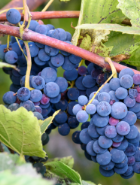
In some of the oldest human settlements, archaeologists have unearthed wine presses cut from stone and a vast array of clay and metal wine vessels.
It is symbolic that, St. Nino, who brought Christianity to Georgia, made a cross from vine stems. The winding characters of the Georgian alphabet reflect the trailing growth of the vine; it is found as a decorative motif in Georgian architecture and as an ornamental device it is often interwoven with capital letters in old Georgian manuscripts.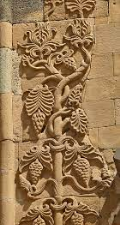
-
Prometheus (Amirani)
Ancient Greek’s legendary Prometheus was punished by the Gods for bringing fire to humans and was chained on a peak in the Caucasus. Amirani, the hero of a Georgian epic, was said to be chained on Mt. Shkhara, 5,068 meters, resembling the Classical Prometheus.
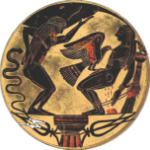
Amirani is the name of a hero of a Georgian epic. He was the son of Dali, the Georgian goddess of the hunt. Raised by a hunter he fought against the evil spirits, dragons, and giants. Finally, Amirani defies God by bringing fire to humans and introducing metal and metal work to humankind. Just like Prometheus, Amirani is punished and chained on a high peak of the Caucasus Mountains. An eagle eats his liver in the day, but it heals itself every night.

-
The Myth of the Argonauts and Golden Fleece
33 centuries ago the Argonauts started their Mythical Journey to capture The Golden Fleece; Jason’s story predated Homer’s Odyssey and describes events which have taken place in Golden Age.

“Here in Georgia the sacred place of the bull cult protected by its snakes, in the land where the ram was held sacred and the fleece was used to gather gold, was further striking evidence for the truth of the tale. For me that moment on the muddy temple mound near Kobuleti was the end of the search, as it must have been for Jason, close on thirty-three centuries earlier.” - Tim Severin, british historian and explorer

Golden figure of a
Lion.
2500-3000 BC -
Medea & Medicine
It’s believed, that medicine comes from the name of Medea, daughter of The King of Colchi, famous for her healing power. Medea cast a spell on the snake and put it to sleep, Jason takes the Golden Fleece
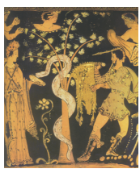
How does the legend of the Argonauts end?
King Ayetes seemed invincible… but Medea, the charming princess famous for her healing powers, fell in love with Jason. It was only with her help that the Argonauts managed to overcome their challenges and seize the treasure of Colchis. Medea, strong and passionate, is of completely different identity from the female stereotypes of the time. She unrelentingly protects her love for Jason and is invincible in her pursuit of main goal.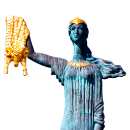
Statue of
Medea in
Batumi -
Christian Bedrock
As the state religion since IV century, Orthodox Christianity has played a major role in Georgian history and culture, defining National values and country’s European vector of development.
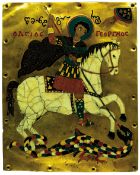
Georgia was one of the first countries in the world to officially adopt Christianity, in AD 337, but its history goes back much, much further. Christianity was first preached in Georgia by the Apostles Simon, Andrew and Matthias in the 1st century. Later in 4th century the conversion of Georgia to Christianity is credited to St. Nino of Cappadocia. The Georgian Orthodox Church, originally part of the Church of Antioch, gained its autocephaly in the 5thc. The Bible was also translated into Georgian in the same century.
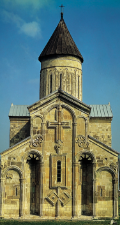
-
- Chakrulo
- Shen Khar Venakhi
- Tsintskaro
- Krimanchuli
- Mkhedruli
- Chela
- Suliko
- Guls Rad Miklav
- Mravaljamieri
Georgian Polyphonic Singing
Georgian polyphonic singing, recognized by UNESCO as an Intangible Heritage masterpiece, dates back to the ancient times and was, and even nowadays is, an essential part on every stage of human life. The songs accompanied every activity, festivity and leisure time.
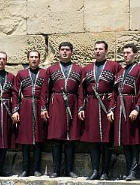

Georgian singing, by its textures and vocal timbres, sounds mystical. Much of the music defies the conventions of harmony and counterpoint. The polyphonic songs contain three, or even four, independent melodic lines, functioning with great melodic and harmonic independence.
The Georgian Polyphonic song “Chakrulo” was cited as a prime example and included on the Voyager Golden Records that were sent into space on Voyager 2 (August 20, 1977) and
Voyager 1 (September 5th, 1977).


-

- Khorumi
- Khevsuruli
- Samaia
- Juta
- Acharuli
- Lazuri
- Project Transformation
Georgian National Dance
The history of Georgian national dance is as old as Georgia itself. They impress with the burning rhythms, incredible beauty and strength, as well as colourful costumes. Dances come from different provinces, expressing the Georgian nature and identity in an impressive manner.
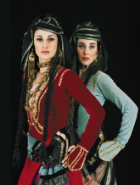

Georgian dances represent a live history book expressing the centuries of Georgian art, culture, and tradition. In different regions of the country unique dancing movements were appearing and passed from generation to generation. The dances of inhabitants of Caucasus Highlands are characterized by sharp and rapid movements while in lowlands, the dances are quieter and smoother. Some dances are gentle, romantic, and graceful, others more playful. Of particular importance are the war dances filled with courage and brevity.


-
Qvevry Vine
The “qvevri” winemaking tradition counting over 8000 harvests is unique to Georgia and is becoming a worldwide brand. Georgian archaic winemaking skill of producing wine in clay qvevri vessels was first mentioned in pre-Christian Greek and Roman historical annals.
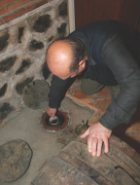
The qvevri winemaking technique is unique to Georgia and is on the list of the Intangible Cultural Heritage of UNESCO. The earliest samples of qvevri date to the early Iron age (6th millennium BC). The winemaking process involves pressing the grapes and then pouring the juice, grape skins, stalks, and pips into the qvevri. Knowledge and experience of qvevri manufacture and winemaking passes down from generation to generation.
“Qvevri”, a special earthenware vessel of clay used for
making, maturation and storage of wine.

-
Supra and Tamada tradition
Georgian Supra is an essential part of Georgian lifestyle with abondance of wine, the toasts of the Tamada, the beautiful Georgian songs, the romantic atmosphere and much more – the way to communicate and being together.
.png)
There is no meal without wine and accordingly no wine without a tamada. The tradition of the supra is a trademark of Georgian Hospitality. About a supra, Georgians humbly say, “Bread, cheese and a kind heart… What else do we need?” That’s just a saying – In fact, at a dinner party and celebrations you can expect a great variety of delicious food, wine, and endless joy. Surely qvevri wines, supra and traditional dinner parties are of the same age…
Toast master - “Tamada” 500-700 BC
A Selection of Georgian Cuisine
It doesn’t matter if you are in mountains or lowlands, in the large cities or remote villages, the flavour of local cuisine will lead you through the different regions of Georgia and offer the possibility to feel the whole taste of the unmistakably distinctive and unforgettable Georgian dishes with all kinds of meat, fish, vegetables with garlic, walnuts, and various herbs and spices.
A Selection of Georgian Cuisine
-

Khachapuri
Bread with cheese filling, described by foreigners as ‘Georgian pizza’. Each part of Georgia has its own unique Khachapuri with its own special flavour, composition and shape.
-
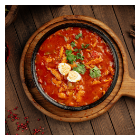
Chakhokhbili
The original Chakhokhbili was prepared with ‘Khokhobi’ (Pheasant) and was a popular festive dish. Chakhokhbili made with chicken tastes almost as delicious.
-
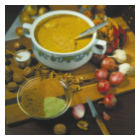
Satsivi
It takes a long time to prepare Satsivi – a traditional dish for the New Year feast. It is turkey or chicken with a lot of oriental and local spices and walnuts.
-
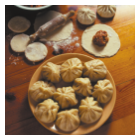
Khinkali
The delicious food of the people in the east and north mountainous regions. It is a boiled dumpling filled with minced meat in dough. In the mountain regions people mix in special spices.
-
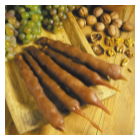
Churchkhela
A yummy and wholesome delicacy of nuts or raisins threaded onto a string. The string is then dipped repeatedly in simmering grape juice.
It doesn’t matter if you are in mountains or lowlands, in the large cities or remote villages, the flavour of local cuisine will lead you trough the different regions of Georgia and offer the possibility to feel the whole taste of unmistakably distinctive and unforgettable Georgian dishes with all kinds of meat, fish, vegetables with garlic, walnuts and various herbs and spices.
Georgians treat guests as “a Gift of God”, as old saying teaches. Wherever you go, you will be welcomed with open heart and joy, with wine and food, dinner parties, often accompanied by songs and dances.
 alt.png)

The Georgian “blue tablecloth”, decorated with beautiful figures each with their own unique symbolic meanings, has been an integral part of Georgian culture for three centuries. The tablecloth was granted the status of a UNESCO material monument.

Old Tbilisi at night

Abanotubani, Tbilisi

Alaverdi Cathedral (11th C), Kakheti Province

Mount Ushba (4710m), Svaneti Province

Lamaria Church, Village Ushguli, Svaneti Province

Ananuri Architectural Complex (15th-17th C), Aragvi Valley

Svanetian Singers

Khorumi Dance

Dinner at private house

Georgian Wine testing
... the combination of uniqueness and beauty
A country with an amazing cluster of cultures and traditions, an ancient history, fascinating landscapes from the snowy peaks of the Caucasus Mountains to fertile lowlands and vineyards, from steppes and deserts to wetlands and subtropics; a patchwork of impressive rock-cut monasteries and cave towns, millennia-old archaeological sites and remote areas, and much, much more…
Georgians treat guests as “a Gift of God”, as the old saying goes. Wherever you go, you will be welcomed with an open heart and joy, with wine, food, and dinner parties, often accompanied by songs and dances.
CLICK TO SEE OUR MOST WANTED TOURS EXPLORING GEORGIA
GEORGIA 
Territory: 69,700 sq km
Population: 3 688 600
Capital City: Tbilisi - 1 200 000
Main Cities: Batumi - 173 700, Kutaisi - 130 000
Main Airports:
Tbilisi International Airport - TBS
Batumi International Airport - BUS
Kutaisi International Airport - KUT
Official Language: Georgian
Script: Georgian (33 Letters)
Climate: A humid subtropical climate in Western Georgia and subtropical to moderate in Eastern Georgia
Time zone: GMT +4 (FIXED- No Daylight Saving Time)
Main Religion: Orthodox Christian
Currency (Code): Lari (GEL - Georgian Lari)
Telephone: Country code: 995 Area code for Tbilisi: 32
Electricity: 220 volt, 50 Hz.
Socket Type: Europlug, Schuko
Visa: Visa is not required for Georgia for the citizens of the USA, Canada, Brazil, Argentina, Japan, Israel, Turkey, citizens of EU member countries and CIS - full list is available on www.mfa.gov.ge. Those, who require visa for Georgia will be able to obtain e-visa through www.evisa.gov.ge. Passport: Passport must be valid for at least six months.
National Holidays:
1-2 Jan / New Year Holiday; 7 Jan / Christmas; 19 Jan / The Epiphany; 3 Mar / Mother's
Day; 8 Mar / Women's International Day; 9 Apr / Day of National Unity; 9 May / Victory
Day over Fascism; 12 May / Commemoration Day of St. Apostle Andrew; 26 May /
Independence Day of Georgia; 28 Aug / the day of the Assumption of the Virgin Mary; 14
Oct / 'Mtskhetoba' (Holiday of Svetitskhovloba), 23 Nov / St. George's Day.
* Easter Holiday in Georgia is on variable dates each year (Friday to Monday)


















